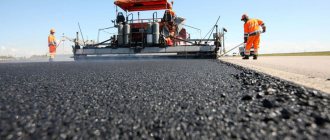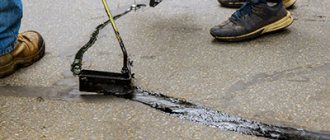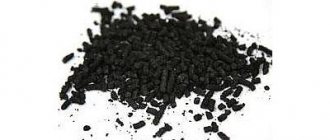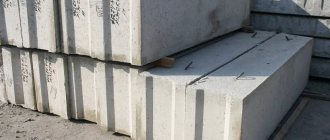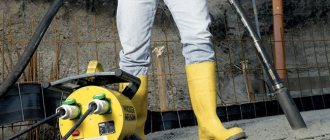Asphalt pavement is the most popular material for highway construction around the world. In addition to roads, highways and highways, asphalt pavement is used in the construction of airfields, parking lots, local areas, pedestrian areas and much more.
Before starting construction, you need to decide on the choice of asphalt mixture. The quality of the canvas, its service life, material consumption and financial burden will depend on the correct choice. We will tell you how to choose an asphalt surface, what you need to consider when choosing, what the asphalt can be, as well as some features of road construction.
Categories of loads on asphalt pavement
| Load type | Decoding |
| Small | Pedestrian areas only: sidewalks, paths, local areas, courtyards, etc. |
| Small | Personal parking for cars, driveways, garages, parking lots, etc. |
| Average | Roads on which only passenger vehicles will travel |
| High | Roads along which passenger and freight transport will travel |
| Very high | Expressways, federal highways, airfields, etc. |
For areas with low load, you can equip an asphalt pavement with low material consumption, as well as with a composition from the budget category - this will be quite enough. For objects with high and very high loads, it is necessary to use more asphalt concrete with the best characteristics.
Let's sum it up
The brand cannot be used as the only parameter for selection, because under the same label there are mixtures with completely different purposes. The same mark can be placed both on durable material, the basis of which is crushed stone, and on sandy asphalt concrete, which is not intended for heavy loads.
In total, there are three grades of asphalt, describing 4 characteristics of the material: its composition, density and porosity, conditions during road work and type depending on the components. Each brand reflects the level of quality of the mixture used for its intended purpose, because there are high-strength mixtures for highways and less durable ones for pedestrian paths.
Main types of asphalt mixtures
First of all, asphalt mixtures can be classified by temperature and installation method. Thus, there are 3 main types of asphalt concrete:
- Hot asphalt;
- Cold asphalt;
- Cast asphalt;
Hot asphalt
is most in demand in road construction, as it has high performance characteristics combined with moderate cost. When laying, the mixture should be heated to 110-130°C (that’s why it is called hot), and the air temperature should not be lower than +5°C. These requirements are due to the presence of viscous bitumen in the composition.
This asphalt coating is quite strong, hard, wear-resistant and durable. The lion's share of roads is built from hot asphalt. At the same time, hot asphalt concrete can also be used for personal needs, the construction of pedestrian areas, as well as for pothole repair.
Cold asphalt
has lower physical and mechanical characteristics than hot mixtures. A distinctive feature is that such asphalt is produced in a form ready for laying. In other words, this mixture does not need to be heated, but can be applied immediately. The air temperature during installation may be sub-zero.
However, due to its relatively low characteristics, cold asphalt is not used for highway construction. Moreover, such asphalt concrete is suitable for pothole repair and use in pedestrian areas. This mixture can be laid without the use of heavy special equipment.
Cast asphalt
is a liquid mixture that does not require compaction, unlike cold and hot asphalt. Before asphalting, the mixture must be heated to 190-230°C. Cast mixtures have maximum density, and after laying they gain strength during the cooling process, due to which they do not need to be compacted.
Cast asphalt concrete has the highest performance characteristics, superior to hot and cold mixes. However, due to its high cost, it is not used as often as hot asphalt.
Laying cast asphalt concrete requires special equipment and machinery. However, since the mixture does not require compaction, the use of road rollers or hand tools for compaction is also not necessary.
Features of asphalting paths and sidewalks
The general scheme for laying asphalt is quite universal. It remains the same for all cases of its use. Therefore, we will not analyze it in detail.
If you need step-by-step instructions, we recommend that you read the relevant articles on our website:
- Technology for laying cut asphalt
- Hot asphalt laying technology
- Cold asphalt laying technology
Here we will focus on the main nuances that need to be taken into account when carrying out work.
The arrangement of paths and sidewalks has the following features:
- Thickness of the asphalt concrete layer If you are laying out a path on your property or in the garden, then you do not need to lay a thick layer of material - 3-4 cm will be enough (5-6 cm before compaction). On central city streets, the thickness is increased to 6 cm - in case cleaning equipment and other light vehicles drive on the sidewalk. And in areas with particularly heavy traffic, asphalt is laid in two layers, 4-6 cm each. This scheme, for example, is used in Moscow.
- Equipment Road pavers will not turn around on the sidewalk, so they are laid using small-sized equipment - small self-propelled or manual rollers or vibrating plates. If you are making a path from cold asphalt or asphalt chips, then it can be compacted by hand. But this option only works in warm weather and takes longer. As a last resort, you can roll the coating with car wheels. But this makes it more difficult to achieve uniform compaction.
- Technological properties of asphalt concrete mixtures This point follows from the previous one. Since heavy equipment is not used for such work, the asphalt must be flexible and compactable. Do not use ABS with a high content of crushed stone (types A, B) or large (more than 20 mm in diameter) asphalt chips for arranging paths. They will be very difficult to work with.
Another point that is relevant here is the appearance of the tracks. After all, owners of private houses usually want their site to look neat and pleasing to the eye. But the asphalt on city streets often seems gray, dull and dull. Is it possible to make it “play”? Let's take a closer look at this.
What composition can an asphalt surface have?
The composition of asphalt concrete directly affects the quality and other characteristics that the asphalt pavement will have. In addition to the set of components, their proportions also play an important role. Therefore, it is best to contact a road construction company that has its own asphalt concrete production.
The composition of the asphalt mixture will change when at least one component is added, but today there are 3 main options:
- 1. Sandy asphalt;
- 2. Asphalt crumbs;
- 3. Crushed stone-mastic asphalt;
Asphalt pavement made from sandy asphalt concrete
has a fairly homogeneous structure, and its main component is sand. It is a budget option, suitable for arranging pedestrian areas, access roads, and parking lots for personal vehicles. Can also be used for local roads where light or medium traffic is expected.
Crushed stone-mastic asphalt concrete
is the highest quality option, perfect for paving areas with any load: from low to very high. The composition includes hard rocks (70-80%), creating a reliable stone “skeleton” of the road surface.
The composition also contains special cellulose fibers that prevent bitumen from spreading. Due to its high characteristics, asphalt pavement made from crushed stone-mastic asphalt concrete is the main one in many countries around the world.
Asphalt crumbs
It is crushed asphalt, due to which this material has a budget cost. However, this does not mean that such asphalt pavement will be of poor quality. If the crumb was obtained, for example, from crushed stone-mastic asphalt concrete, then its quality will be quite high. Suitable for pedestrian areas, driveways, parking lots and roads with light to medium traffic.
Classification of asphalt concrete mixtures by technical characteristics and composition
To simplify the choice, asphalt is divided into brands and types. Main brands of asphalt concrete:
- Brand 1. This group includes ABs of different compositions and densities, which are united by a common quality - high strength. The main use of these materials containing crushed stone, quartz sand, bitumen, and mineral powders is to create the bottom layer of the road. Among ABs, brand 1 has the highest cost.
- Brand 2. These materials, the technical characteristics of which are slightly lower than those of AB brand 1, are distinguished by their budget cost and versatility of use. They are in demand in a wide range of road works - during the construction and repair of public roads, landscaping of private areas, city parks and public gardens.
- Grade 3. Dense but low-strength material, which does not contain crushed stone. Such ABs are made on the basis of sand and mineral powders. They are in demand for repairs and installation of coatings that are not designed to withstand heavy loads. Grade 3 is a type of asphalt concrete intended for constructing pedestrian paths, sidewalks, alleys in gardens and parks, organizing areas near private houses and in the courtyards of medical or educational institutions. It is also often used for pothole repair of road surfaces.
How else is asphalt concrete classified?
In addition to placement temperature, compaction requirements and composition, asphalt mixtures can be classified according to:
- graininess;
- porosity;
- brand;
- color;
In addition to sandy asphalt, mixtures can be divided into fine- and coarse-grained.
Fine-grained asphalt concrete includes fractions from 5 to 20 mm, while coarse-grained asphalt concrete – up to 40 mm.
When laying asphalt, both options are used: first, coarse-grained asphalt is laid, and fine-grained asphalt is laid on top. This is necessary for the asphalt surface to have a high density. Based on porosity, asphalt
is usually divided into 3 categories:
- dense (up to 1.5%);
- porous (from 5 to 12%);
- highly porous (from 12 to 18%);
A high-quality asphalt mixture has low porosity, i.e. is dense.
Brand of asphalt concrete
indicates the percentage of the main component, for example, crushed stone. Today there are 5 brands: A, B, C, D and D.
| Brand | Crushed stone content |
| A | from 50% and above |
| B | 40-50% |
| IN | 30-40% |
| G and D | Sand mixtures without crushed stone |
Also, asphalt pavement can be of different colors.
This is achieved by including the following components:
- coloring pigments;
- binder (to replace bitumen);
- mineral filler (not all fillers are suitable);
Today it is possible to obtain asphalt coating of any color according to the RAL scale. However, only on the condition that a special colorless substance acts as a binder. If, for example, petroleum bitumen remains the binding component, only some dark shades can be obtained.
Colored AB has a higher cost than similar gray or black asphalt, however, due to the wide selection of colors, such asphalt concrete is quite in demand.
What can one brand of asphalt include?
One brand of asphalt concrete can include two mixtures with completely different characteristics. Here are two versions of the material with the same markings.
High quality asphalt containing at least 50-60% dense materials such as crushed stone or other rocks. It may also contain special modifiers that increase the quality and durability of the mixture. This asphalt concrete is used for the construction of highways that are subject to enormous load in the form of a large flow of cars.
Asphalt, the basis of which is not stone filler, but sand. Such material is not used either for the construction or repair of highways. The reason is that it is not able to withstand heavy loads. Sand mixture is usually used only for the construction of sidewalks and other pedestrian areas.
It is very important to study the main classifications of asphalt before ordering road work - such preparation will help you choose the most suitable asphalt concrete mixture for a specific task.
How does load affect asphalt thickness?
| Load type | Asphalt concrete thickness |
| Small | 3 centimeters |
| Small | 6 centimeters |
| Average | ~12 centimeters |
| High | ~18 centimeters |
| Very high | up to 30 centimeters or more |
It is worth noting that when laying several layers of asphalt concrete on top of each other, compaction of each layer is required. If this is neglected, the asphalt pavement will deform and also lose its physical and mechanical properties.
How does the base affect the quality of the road surface?
Also, during the construction of roads, the base of the roadway plays an important role - it must be made in full compliance with road construction technology, for which the specialists of the road construction company must take into account a lot of factors.
If the “road cushion” is built with violations in the technological process, then even a high-quality asphalt covering in several layers will soon deform. Therefore, be careful when choosing a contractor.
How to build a road base:
- 1. First of all, you need to conduct reconnaissance of the area and geodetic research.
- 2. All necessary calculations are made and a work plan is drawn up.
- 3. The area is prepared: the area for work is cleared, obstacles are removed, communications are moved, etc.
- 4. Next comes soil preparation: the top layers are removed, the area is leveled, backfilled if necessary, and then compacted with special equipment.
- 5. Geotextiles are laid.
- 6. A sand layer is poured out, which must be compacted.
- 7. Geogrid is laid.
- 8. Crushed stone of different fractions is poured (first large, then small), after which the crushed stone layer is compacted with heavy road rollers.
Only after this can you begin laying asphalt concrete to form the finished asphalt surface. At this stage, as at all previous ones, it is important to comply with road construction technology, as well as to efficiently compact the road surface with special equipment. If we are talking about asphalting pedestrian areas or parking lots for personal vehicles, the asphalt technology is simplified. However, the need for quality sealing never goes away. The only exception will be cases using cast asphalt concrete. If you want to find out how well the road surface was compacted, you can use the calculation of the asphalt compaction coefficient. This test is carried out in laboratory conditions and allows us to determine whether the actual density of the asphalt pavement meets GOST standards.
— An indicator of the level of density or porosity of the finished asphalt
This characteristic describes the porosity of asphalt created after final compaction. To determine this indicator, a small sample is cut from the finished road. There are the following degrees of density/porosity of asphalt concrete:
- high-density – 1-1.2% pores;
- dense – 2.5-5%;
- porous – 10%;
- highly porous – 10-18%.
In most cases, the most durable materials are considered to be those with a minimum level of porosity and maximum density. However, such characteristics can be misleading, because a high level of density does not always guarantee strength. For example, the residual porosity of the sand mixture is only 1%, but its strength is much lower than crushed stone asphalt concrete.
What are the advantages of asphalt pavement?
As mentioned at the beginning, asphalt pavement is the most popular material for arranging various road surfaces. Popularity is achieved solely due to the high performance characteristics and moderate cost of asphalt concrete.
The main advantages of asphalt pavement include:
- High strength;
- Good hardness;
- Resistance to deformation;
- Wear resistance;
- Moisture resistance;
- Long service life;
- Resistance to high temperatures;
- Resistance to low temperatures;
- Immunity to temperature changes;
- Maintainability;
- Safety for the environment, despite the use of bitumen;
- The asphalt surface is even and smooth;
- This coating does not generate dust and does not wear off;
- Variability of colors;
- Moderate cost;
All these advantages make asphalt the optimal option for paving, and in many areas of application. Another advantage is that asphalt concrete has many varieties to suit any needs and budget.
Thanks to this, there is no need to buy expensive crushed stone-mastic asphalt concrete for the construction of, for example, a garden path. It is enough to purchase budget asphalt chips or sand asphalt to satisfy the need.
If you need to repair an asphalt surface, you can use cold asphalt in bags, which allows you to carry out pothole repairs without special skills or the use of special equipment.
Content:
- Types of asphalt 1.1. Cold 1.2. Hot 1.3. Cast 1.4. Natural 1.5. Sandy 1.6. Sulphated 1.7. Milled 1.8. Color 1.9. Coarse grain 1.10. Fine grain 1.11. Rubber 1.12. Plastic 1.13. Stamped
- How to choose the right asphalt
Asphalt concrete is used in road construction.
This is an artificial building material obtained by mixing and compacting asphalt concrete mixture (ABS), bitumen, sand, crushed stone and mineral compounds selected in the correct proportions. All components are connected in a heated state, due to which they reliably adhere to each other and form a dense road layer after compaction and rolling. Construction clients typically want the best asphalt in the world to be used on their project. But let’s immediately make a reservation that it is impossible to call any one type of asphalt concrete ideal. To understand which composition will be optimal for solving specific problems, it is necessary to take into account the location, purpose and congestion of the future road.
Therefore, there is no need to look for the best asphalt. Instead , you should figure out which of the available types of coverage is best suited for your specific situation.

